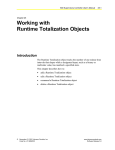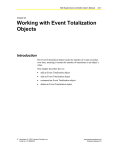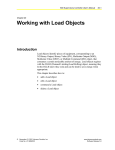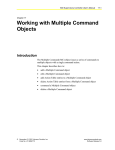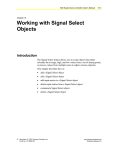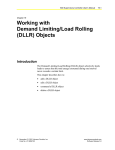Download N30 Supervisory Controller User`s Manual: Chapter 23: Working
Transcript
N30 Supervisory Controller User’s Manual 23-1 Chapter 23 Working with Analog Totalization Objects Introduction An Analog Totalization object maintains a total for the data recorded at an analog sensor. It answers the question “How much?” and is typically used to measure the consumption of a supply, such as steam, electricity, or chilled water. The input sensor provides a value corresponding to the amount of consumption or flow. This chapter describes how to: • add an Analog Totalization object • edit an Analog Totalization object • command an Analog Totalization object • delete an Analog Totalization object © November, 2001 Johnson Controls, Inc. Code No. LIT-6892230 www.johnsoncontrols.com Software Release 5.0 23-2 N30 Supervisory Controller User’s Manual Key Concepts Analog Totalization Object The Analog Totalization object can be added to any container or object in the hierarchy. The Analog Totalization object references any analog attribute value for input data calculations. Note: The Input Reference of an Analog Totalization object should refer to a signed or unsigned integer, a signed or unsigned long, or a floating point based attribute in order to perform as intended. Analog Totalization objects referencing other attribute data types (e.g., Boolean) yield unusual results, though not necessarily unusable results. Neither the VT100 nor Project Builder give an error message when this object is attached to any attribute other than signed or unsigned integer, signed or unsigned long, or floating point based attributes. Typical uses of Analog Totalization include: • to determine how many kilowatt/hours were used in a week • to determine how much steam is used in a week • to totalize a calculated value (for instance, degree days) The Analog Totalization formula and an example are illustrated in Table 23-1. Table 23-1: Analog Totalization Formula and Example Calculations Analog Totalization Calculation Formula Present Value + (Input x Period)/(Time Factor x Scalefactor) = Present Value (New) Example 200 gallons + (20 gallons x 1 minute)/(60 seconds x 1) = 220 gallons N30 Supervisory Controller User’s Manual 23-3 Analog Totalization Object Reset Table 23-2 describes under what conditions the reset of the Analog Totalization object occurs and what conditions result due to the reset. Table 23-2: Analog Totalization Reset Reset Conditions Occurs: • When a Reset Command is received. • When the following attributes are rewritten: Low Cutoff Value Timebase Scalefactor Reset Totalize Limit, when the Present Value has reached the currently defined Totalize Limit value Rollover, when the Present Value has reached the currently defined Totalize Limit value • Following a return from a Totalization object’s disabled state to an enabled state • Termination of ongoing calculations • Restoration of the Present Value and Rollover Count values to their initial states • Retriggering of all Change-of-Value state changes Results In: Attributes The values of an object’s attributes determine how the object operates. The Analog Totalization object attributes described below are listed in the order that they appear on the screen. Entry requirements for these attributes are in Table 23-4. For additional information about the Analog Totalization object and its attributes, refer to the Object Dictionary. Object Name Identifies the object on the user interface. Description Provides optional information to further describe the object. Object Type Indicates the kind of object, such as Schedule, N2 Analog Input, or Analog Totalization. 23-4 N30 Supervisory Controller User’s Manual Object Category Determines the general classification of an object to help define user access capability and message routing. Enabled Indicates if the object is active and executing an operational condition. Input Reference Specifies the object and attribute totalized by this object. If this attribute is unreliable or falls below the Low Cutoff Value, totalization is temporarily suspended. Timebase Establishes the time frame on which the calculated totalization value is based. Processing a write of this attribute sets the Reset condition. Scalefactor Indicates the value used to scale the totalized value to either a larger or smaller value than would otherwise result. Processing a write of this attribute sets the Reset condition. This value must be greater than zero. Totalize Limit Defines a threshold value the Present Value must meet or exceed in order for the totalization object to take special action. The special action taken depends on the setting defined for the Rollover attribute. Low CutOff Value Defines a minimum input value; values beneath this minimum input value are not totalized. With this attribute, sensor errors associated with the low readings of flow sensors can be eliminated. Writing this attribute forces a Reset condition. Rollover Defines the special action that the Analog Totalization object must take when the Present Value reaches the Totalize Limit value. If the Rollover attribute is set to False, the Runtime Totalization object ceases further operation when the Present Value equals or exceeds the Totalize Limit value. If it is True, it resets the Present Value to 0.0 and resumes a new totalization cycle. Units Indicates the measurement units of this object. N30 Supervisory Controller User’s Manual 23-5 Display Precision Indicates the rounded position and decimal places to display for this object. Present Value Represents the current totalized value of the object. Writing this attribute (changing it) forces the Reset condition. Present Value appears to the right of the object name in the container hierarchy after the object is created. Reset Forces a Reset condition and then returns to False, after a write of this attribute to True. The reading of this attribute (viewing it on the user interface) always returns a False condition. This attribute is not displayed on the attributes screen but it is useful for advanced diagnostics. Rollover Count Indicates how many rollovers have occurred since the object started totalization, when the Rollover attribute is True. This is an internal attribute value. It is not displayed on the attributes screen but it is useful for advanced diagnostics. 23-6 N30 Supervisory Controller User’s Manual Procedure Overview Table 23-3: Working with Analog Totalization Objects To Do This Follow These Steps: Add an Analog Totalization Object Browse to and highlight the container or object where the Analog Totalization object is to be added. Press the F3 (Add) key. Select Analog Totalization and press Enter. Fill in the fields using Table 23-4. Press the F3 (Save) key. Check the User Assistance area of the screen to verify if the save was successful or if there were errors. Press any key to continue. Press the F4 (Cancel) key to return to the container hierarchy. Edit an Analog Totalization Object Browse to and highlight an Analog Totalization object. Press Enter to open the object. Press the F3 (Edit) key. Edit the fields using Table 23-4. Press the F3 (Save) key. Check the User Assistance area of the screen to verify if the save was successful or if there were errors. Press any key to continue. Press the F4 (Cancel) key to return to the container hierarchy. Command an Analog Totalization Object Browse to and highlight an Analog Totalization object. Press the F2 (Command) key. Use the Spacebar and the Backspace key to cycle through the list until the desired command appears. Press Enter. Delete an Analog Totalization Object Browse to and highlight an Analog Totalization object. Press Enter to open the object. Press the Delete key. Press the Tab key to confirm the deletion. N30 Supervisory Controller User’s Manual 23-7 Detailed Procedures Adding an Analog Totalization Object To add an Analog Totalization object: 1. Browse to and highlight the container or object where the Analog Totalization object is to be added. 2. Press the F3 (Add) key. The Add Object list appears. 3. Select Analog Totalization and press Enter. The Analog Totalization object attribute screen appears (Figure 23-1). Figure 23-1: Analog Totalization Object Attribute Screen 4. Fill in the fields using Table 23-4. 23-8 N30 Supervisory Controller User’s Manual Table 23-4: Attribute Entry Requirements Screen Area Attribute Required Default Options/Range Object Object Name No Blank Maximum 32 characters Invalid characters: @ . ? * $ # : ’ [ ] If not completed, the system assigns a name. Description No Blank Maximum 40 characters Object Type Yes Analog Totalization The default is preset and cannot be changed. Object Category Yes HVAC Use the Spacebar and Backspace key to view and select options: HVAC, Fire, Security, Services, Administrative. Enabled Yes True Use the Spacebar and Backspace key to view and select options: True, False. Input Reference Yes Timebase Yes Hours Use the Spacebar and Backspace key to view and select options: Hours, Seconds, Minutes. Scalefactor Yes 1.0 A float value greater than 0 Totalize Limit No Blank A float value greater than 0 Low Cutoff Value Yes 0.0 A float value greater than 0 Rollover Yes False Use the Spacebar and Backspace key to view and select options: True, False. Units Yes Blank Use the Spacebar and the Backspace key to cycle through the list of options. Refer to Units Enumeration Set in Appendix A: Object Enumeration Sets of the Object Dictionary (LIT-694980). Display Precision Yes 10ths Use the Spacebar and Backspace key to cycle through the list of options. Refer to Display Precision Enumeration Set in Appendix A: Object Enumeration Sets of the Object Dictionary (LIT-694980). Engineering Values Display If this Analog Totalization object is being added to a container, the exact name of the object and attribute to be totalized must be entered. If this Analog Totalization object is being added to an object, the name of that object appears automatically with its Present Value attribute. Example: HEATING SP.Present Value. Present Value is the default attribute that appears. 5. Press the F3 (Save) key. 6. Check the User Assistance area of the screen to verify if the save was successful or if there were errors. If errors were detected, correct them and resave the entries. Once the save is successful, continue with Step 7. 7. Press any key to continue. 8. Press the F4 (Cancel) key to return to the container hierarchy. N30 Supervisory Controller User’s Manual 23-9 Editing an Analog Totalization Object To edit an Analog Totalization object: 1. Browse to and highlight an Analog Totalization object. 2. Press Enter to open the object. Note: Additional attributes appear. Refer to the Object Dictionary for more information. 3. Press the F3 (Edit) key. The Analog Totalization object attribute screen appears (Figure 23-1). 4. Edit the fields using Table 23-4. 5. Press the F3 (Save) key. 6. Check the User Assistance area of the screen to verify if the save was successful or if there were errors. If errors were detected, correct them and resave the entries. Once the save is successful, continue with Step 7. 7. Press any key to continue. 8. Press the F4 (Cancel) key to return to the container hierarchy. Commanding an Analog Totalization Object To command an Analog Totalization object: 1. Browse to and highlight an Analog Totalization object. 2. Press the F2 (Command) key. The Command field appears. 3. Use the Spacebar and the Backspace key to cycle through the list until the desired command appears. The Analog Totalization object supports the commands listed in (Table 23-5). Table 23-5: Supported Commands Command Description Reset Resets the Present Value to zero. Enable Instructs the Analog Totalization object to start analog totalizing the Input Reference object. Disable Instructs the Analog Totalization object to stop analog totalizing the Input Reference object. 4. Press Enter. 23-10 N30 Supervisory Controller User’s Manual Deleting an Analog Totalization Object To delete an Analog Totalization object: 1. Browse to and highlight an Analog Totalization object. 2. Press Enter to open the object. 3. Press the Delete key. 4. Press the Tab key to confirm the deletion.










